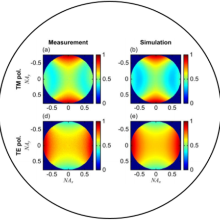However, the design complexity of state-of-the-art devices results in large parameter spaces and complicates the reconstruction procedure in terms of low sensitivities and high cross-correlations. In the framework of a DFG-funded project, the so-called white-light Mueller-matrix Fourier scatterometry was proposed as a novel measurement approach. It combines the well-known techniques of Fourier microscopy, Fourier spectroscopy, and Mueller polarimetry into one apparatus and allows for the measurement of the fully angle- and wavelength resolved Mueller matrix of the sample. Simulation studies show that the increased information content considerably reduces the ambiguities of the reconstruction. Additionally, first proof-of-principle measurements validate the practical feasibility of the sensor concept.
The schematic drawing of the sensor design for the white-light Mueller-matrix Fourier scatterometry is shown above. Measurements are performed in the Fourier plane, where different propagation directions are resolved spatially. By means of Fourier spectroscopy, the individual wavelengths of the broadband illumination are separated and phase information is retrieved in addition to intensities. An additional polarization modulation finally enables the calculation of the angle- and wavelength-resolved, real-valued Mueller matrix.
On the left, Cross-section SEM images of different silicon line gratings are displayed. (a) shows a 150 nm pitch, (b) 116 nm, (c) 96 nm whereas all images are scaled identically. The red profiles illustrate the results of the model-based reconstructions; they agree well with the real profiles.





